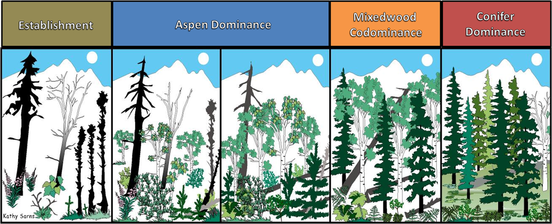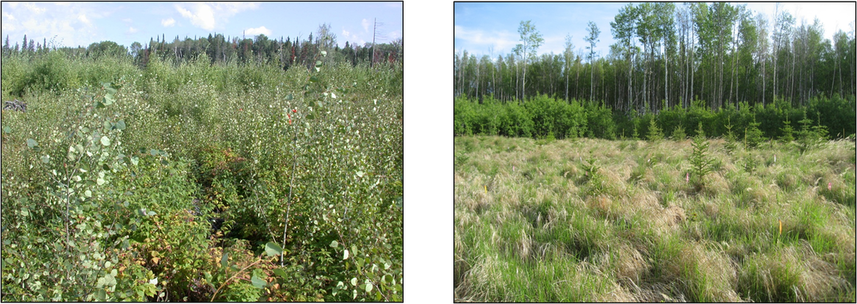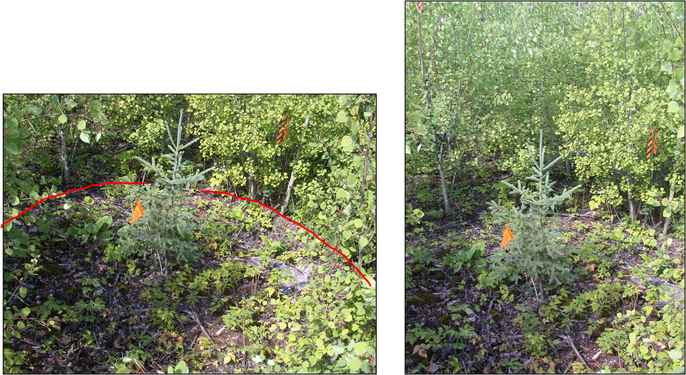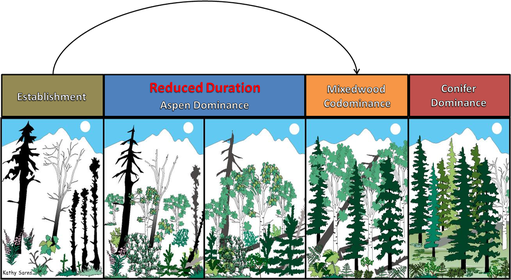Background: Mixedwood Succession
Mixedwood stands of aspen (Populus tremuloides) and white spruce (Picea glauca) dominate the mesic boreal forests of western Canada (Lieffers et al. 1996a). These forests were historically born of stand-replacing fire and are defined by three [general] stages of stand development: early aspen dominance through age 70, mixedwood codominance from age 70-90, and late-successional conifer dominance after year 90 (Rowe and Scotter 1973; Beckingham et al. 1996; Lieffers et al. 1996a, Man and Lieffers 1999). In this sequence, vigorous aspen regeneration follows stand disturbance, and provided a seed source, slower-growing spruce establishes in the aspen understory (Figure 2). Over time, longer-lived spruce replace the dominant aspen overstory, leaving mature stands of spruce (Lieffers and Beck 1994; Lieffers et al. 1996b; Figure 2). In total, late-successional spruce requires 90-150 years to develop (Man and Lieffers 1999).
Figure 2. Generalized graphic of natural mixedwood succession. After stand-replacing disturbance
and initial establishment, boreal mixedwoods go through three general stages of stand development:
Early aspen dominance through age 70, mixedwood codominance from age 70-90, and
late-successional conifer dominance. In total, late-successional spruce requires approximately
90-150 years to develop. (Image: USFWS 2010).
and initial establishment, boreal mixedwoods go through three general stages of stand development:
Early aspen dominance through age 70, mixedwood codominance from age 70-90, and
late-successional conifer dominance. In total, late-successional spruce requires approximately
90-150 years to develop. (Image: USFWS 2010).
Forest Management and Regulation in the Boreal Mixedwoods
In the boreal mixedwoods, clearcutting is the dominant harvest technique (Lieffers and Beck 1994). Although this harvest method encourages aspen regeneration, plantation forestry and heavy site preparation [brushing, mounding, herbicide, etc.] are required to regenerate white spruce in early succession (Lieffers and Beck 1994). Moreover, government reforestation standards demand the reestablishment of white spruce in early-successional mixedwoods (ASRD 2010). Specifically, white spruce must reach a minimum height [30 cm] and achieve a uniform tree distribution [80% occupancy] eight years after harvest (ASRD 2010). These regulations strive to shorten rotations and yield predictable growth/yield volumes for annual allowable cut allocation (Lieffers and Beck 1994). Unfortunately, heavy site preparation for the early white spruce establishment create late-successional spruce dominated stands [i.e. spruce monocultures], effectively “unmixing the mixedwoods” (Pitt et al. 2010; Figure 4). Alternately, withholding vegetation control can yield aspen dominated stands [i.e. aspen monocultures] that impair spruce growth (Pitt et al. 2010; Lieffers et al. 1996a; Boateng et al. 2006; Figure 3).
Figure 3. Aspen dominance in the absence of vegetation control. Figure 4. Spruce dominance under excessive vegetation control: A
(Image: Phil Comeau) requirement for early-successional spruce establishment. (Image:
Phil Comeau)
(Image: Phil Comeau) requirement for early-successional spruce establishment. (Image:
Phil Comeau)
Rationale to Maintain Mixedwood Structure
By definition, boreal mixedwoods contain both hardwood and softwood species; moreover, the maintenance of each component is often beneficial. From a forest management perspective, mixedwood stands efficiently capture light and fix carbon through the partitioning of light resources (Man and Lieffers 1999), thereby increasing yield. [Shade intolerant aspen and shade tolerant spruce simultaneously occupy the same site; spruce utilize the light that passes through the aspen canopy (Man and Lieffers 1999).] Mixedwood stands also have improved soil nutrient availability, given higher rates of nutrient cycling relative to conifer monocultures (Man and Lieffers 1999). [Specifically, aspen foliage decomposes readily and has a higher nutrient content than spruce foliage, promoting enhanced nutrient cycling (Pare and Van Cleve 1993; Van Cleve et al. 1983).] In direct competition with aspen, spruce also tend to be taller, exhibit less taper, and have reduced knottiness, improving wood quality (Man and Lieffers 1999). [Aspen cover encourages “upward growth” and natural pruning (Man and Lieffers 1999).] Mixedwood stand structures also discourage spruce insect damage from white pine weevil (Pissodes strobi) by limiting host tree leader size [bark thickness/leader diameter] and lowering temperatures (Taylor et al. 1996; Stiell and Berry 1985, Sullivan 1961). Moreover, aspen cover can reduce radiative frost damage in young spruce through the retention of longwave radiation (Groot and Carlson 1996). Finally, the maintenance of an aspen canopy can lower the competition of grasses [e.g. bluejoint reedgrass - (Calamagrostis canadensis)] and herbs [e.g. red raspberry - (Rubus idaeus)] that cause spruce regeneration failures (Man and Lieffers 1999).
Mixedwood stands also provide ecological benefits. Mixedwood compositions encourage biodiversity, landscape structure, long-term forest productivity (Andison and Kimmins 1999).
Mixedwood stands also provide ecological benefits. Mixedwood compositions encourage biodiversity, landscape structure, long-term forest productivity (Andison and Kimmins 1999).
Encouraging Intimacy with Trees: Intimate mixtures?
Intimate Mixture Background
‘Intimate mixtures’ provide an alternative to regeneration methods that favor either spruce or aspen. Specifically, intimate mixtures are controlled combinations of aspen and spruce spatially arrayed within a few metres (Pitt et al. 2010; Figures 5-6). In this arrangement, spruce are planted at a lower density, and aspen are controlled within a set radius of each spruce. Overall, aspen and spruce are allocated equivalent growing space within the stand, releasing spruce and creating an accelerated mixedwood structure (Pitt et al. 2010; Figures 5-7).
Intimate Mixture Benefits
By creating an accelerated mixedwood, 'intimate mixtures' develop the species and structural diversity of mid-successional forests while providing environmental shelter [e.g. frost protection] to white spruce (Pitt et al. 2010; Figure 6). Reduced spruce density in 'intimate mixtures' also allows future harvest flexibility and accelerated rotations (Pitt et al. 2010). Specifically, a spruce spacing around 5 metres permits access by ground-based harvesting equipment and causes minimal damage to residual spruce. With ready harvesting access, a two-pass harvest of aspen and spruce could occur, where aspen are removed at age 30 and spruce are allowed to reach sawlog diameters after age 60 (Pitt et al. 2010). Alternately, a single late-rotation harvest could occur, where aspen and spruce coexist until age 80 and are harvested simultaneously.
‘Intimate mixtures’ provide an alternative to regeneration methods that favor either spruce or aspen. Specifically, intimate mixtures are controlled combinations of aspen and spruce spatially arrayed within a few metres (Pitt et al. 2010; Figures 5-6). In this arrangement, spruce are planted at a lower density, and aspen are controlled within a set radius of each spruce. Overall, aspen and spruce are allocated equivalent growing space within the stand, releasing spruce and creating an accelerated mixedwood structure (Pitt et al. 2010; Figures 5-7).
Intimate Mixture Benefits
By creating an accelerated mixedwood, 'intimate mixtures' develop the species and structural diversity of mid-successional forests while providing environmental shelter [e.g. frost protection] to white spruce (Pitt et al. 2010; Figure 6). Reduced spruce density in 'intimate mixtures' also allows future harvest flexibility and accelerated rotations (Pitt et al. 2010). Specifically, a spruce spacing around 5 metres permits access by ground-based harvesting equipment and causes minimal damage to residual spruce. With ready harvesting access, a two-pass harvest of aspen and spruce could occur, where aspen are removed at age 30 and spruce are allowed to reach sawlog diameters after age 60 (Pitt et al. 2010). Alternately, a single late-rotation harvest could occur, where aspen and spruce coexist until age 80 and are harvested simultaneously.
Figure 5. Intimate mixture/radial brushing treatment of aspen Figure 6. Intimate mixture/radial brushing treatment
where competition is removed within a set radius of each of aspen. Aspen shelter is visible in the background.
spruce. The plot radius is defined in red. (Image: Phil Comeau) (Image: Phil Comeau)
where competition is removed within a set radius of each of aspen. Aspen shelter is visible in the background.
spruce. The plot radius is defined in red. (Image: Phil Comeau) (Image: Phil Comeau)
Figure 7. The conceptual acceleration of mixedwood succession through the development
of intimate mixtures. Overall, the duration of aspen dominance is reduced, and spruce
are released, allowing the early-development of mixedwood structure.
(Image: USFWS 2010)
of intimate mixtures. Overall, the duration of aspen dominance is reduced, and spruce
are released, allowing the early-development of mixedwood structure.
(Image: USFWS 2010)
Developing Intimate Mixtures
When developing 'intimate mixtures', the size and timing of [radial] vegetation control treatments must be defined. How big should these treatments be, and when should they be applied to maximize spruce growth? Furthermore, what effect does competing vegetation have on spruce growth?
Hypothesis 1: Larger treatment radii and earlier brushing treatments will increase spruce height, diameter, and leader growth.
Hypothesis 2: Competing vegetation negatively influences spruce growth.
Assumptions
Hypothesis 1: Larger treatment radii and earlier brushing treatments will increase spruce height, diameter, and leader growth.
Hypothesis 2: Competing vegetation negatively influences spruce growth.
Assumptions
- Larger treatment radii decrease aspen's competitive effect on white spruce and alleviate light, moisture, and soil nutrient competition.
- Early brushing treatments provide an extended "reduced competition" state, encouraging spruce growth.
- Excluding site and climatic conditions, inadequate light is the most limiting factor to white spruce. Low light conditions are caused by competing vegetation.




